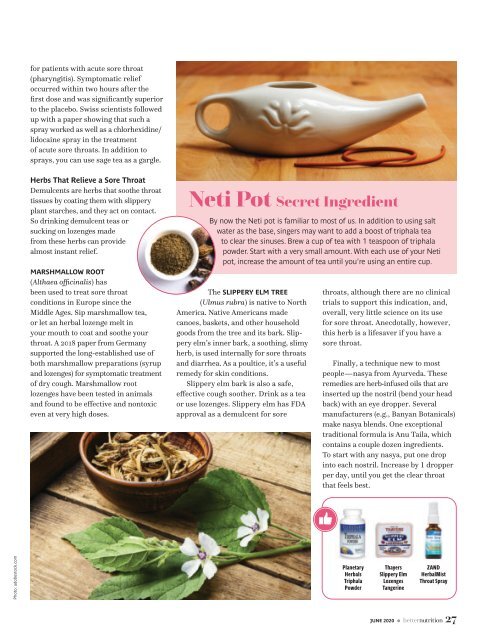You also want an ePaper? Increase the reach of your titles
YUMPU automatically turns print PDFs into web optimized ePapers that Google loves.
for patients with acute sore throat<br />
(pharyngitis). Symptomatic relief<br />
occurred within two hours after the<br />
first dose and was significantly superior<br />
to the placebo. Swiss scientists followed<br />
up with a paper showing that such a<br />
spray worked as well as a chlorhexidine/<br />
lidocaine spray in the treatment<br />
of acute sore throats. In addition to<br />
sprays, you can use sage tea as a gargle.<br />
Herbs That Relieve a Sore Throat<br />
Demulcents are herbs that soothe throat<br />
tissues by coating them with slippery<br />
plant starches, and they act on contact.<br />
So drinking demulcent teas or<br />
sucking on lozenges made<br />
from these herbs can provide<br />
almost instant relief.<br />
MARSHMALLOW ROOT<br />
(Althaea officinalis) has<br />
been used to treat sore throat<br />
conditions in Europe since the<br />
Middle Ages. Sip marshmallow tea,<br />
or let an herbal lozenge melt in<br />
your mouth to coat and soothe your<br />
throat. A 2018 paper from Germany<br />
supported the long-established use of<br />
both marshmallow preparations (syrup<br />
and lozenges) for symptomatic treatment<br />
of dry cough. Marshmallow root<br />
lozenges have been tested in animals<br />
and found to be effective and nontoxic<br />
even at very high doses.<br />
Neti Pot Secret Ingredient<br />
By now the Neti pot is familiar to most of us. In addition to using salt<br />
water as the base, singers may want to add a boost of triphala tea<br />
to clear the sinuses. Brew a cup of tea with 1 teaspoon of triphala<br />
powder. Start with a very small amount. With each use of your Neti<br />
pot, increase the amount of tea until you’re using an entire cup.<br />
The SLIPPERY ELM TREE<br />
(Ulmus rubra) is native to North<br />
America. Native Americans made<br />
canoes, baskets, and other household<br />
goods from the tree and its bark. Slippery<br />
elm’s inner bark, a soothing, slimy<br />
herb, is used internally for sore throats<br />
and diarrhea. As a poultice, it’s a useful<br />
remedy for skin conditions.<br />
Slippery elm bark is also a safe,<br />
effective cough soother. Drink as a tea<br />
or use lozenges. Slippery elm has FDA<br />
approval as a demulcent for sore<br />
throats, although there are no clinical<br />
trials to support this indication, and,<br />
overall, very little science on its use<br />
for sore throat. Anecdotally, however,<br />
this herb is a lifesaver if you have a<br />
sore throat.<br />
Finally, a technique new to most<br />
people—nasya from Ayurveda. These<br />
remedies are herb-infused oils that are<br />
inserted up the nostril (bend your head<br />
back) with an eye dropper. Several<br />
manufacturers (e.g., Banyan Botanicals)<br />
make nasya blends. One exceptional<br />
traditional formula is Anu Taila, which<br />
contains a couple dozen ingredients.<br />
To start with any nasya, put one drop<br />
into each nostril. Increase by 1 dropper<br />
per day, until you get the clear throat<br />
that feels best.<br />
Photo: adobestock.com<br />
Planetary<br />
Herbals<br />
Triphala<br />
Powder<br />
Thayers<br />
Slippery Elm<br />
Lozenges<br />
Tangerine<br />
ZAND<br />
HerbalMist<br />
Throat Spray<br />
JUNE <strong>2020</strong> • 27

















